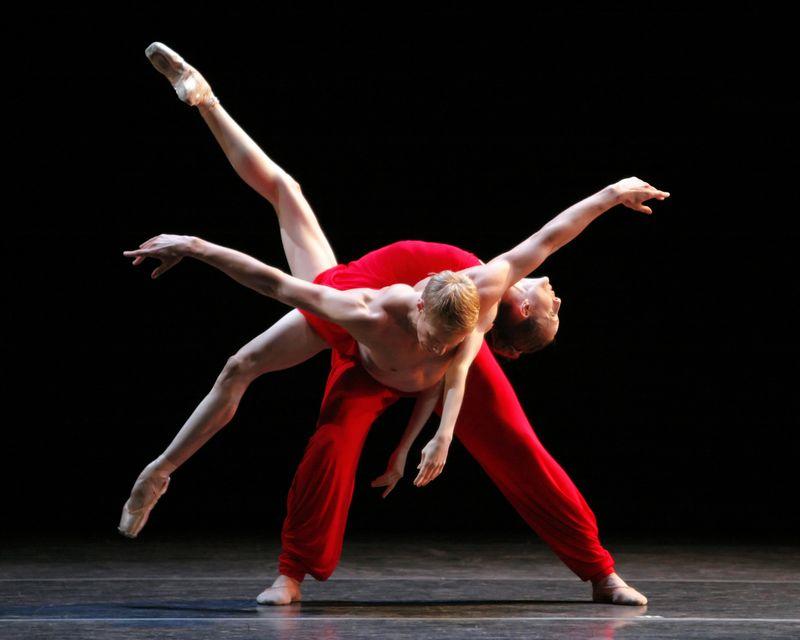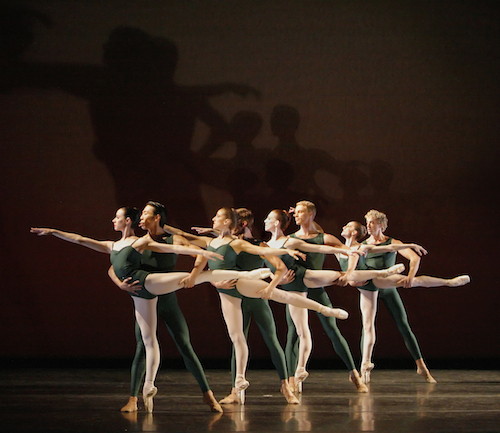Morphoses prog B, Sadler's Wells | reviews, news & interviews
Morphoses prog B, Sadler's Wells
Morphoses prog B, Sadler's Wells
Christopher Wheeldon shows a great piece and a misfire in his company's second bill

In the Ballets Russes centenary year it’s worth remembering that the iconic Diaghilev ballets were only the few lasting landmarks in a sea of constant novelties and shipwrecks. So if Christopher Wheeldon doesn’t take many great reviews back to the States after Morphoses’ third visit to London, he should be roundly applauded for being so generous to fellow-choreographers and mounting this enterprise in stark times that need initiative more than ever.
Continuum, his second work to Gyorgy Ligeti’s piano music after his famously fine Polyphonia, is just as magnificent, another ballet from the dark, astringent side of his talent which shouts what a master dancemaker Wheeldon can be. The music refuses to ingratiate - the notes spill out of the two pianos in haphazard dissonances, or sound long, mysterious chords - while the choreography’s superb command of pose, manipulative ingenuity and damn-your-eyes stillness demonstrates that only someone with a strong thought to utter can afford to speak it deliberately.
 Continuum is remarkable for its bold and unhurried curiosity about the iconic male-female balancing act. There are shades of Balanchine’s Agon in its almost physiotherapeutic pas de deux, some grippingly slow promenades where the man parades the woman in fascinating ways. In one strange sequence, the man crawls on all fours around the woman’s feet while she leans on him in a deep penché, a laconic, inviolable goddess in a mystical aesthetic realm.
Continuum is remarkable for its bold and unhurried curiosity about the iconic male-female balancing act. There are shades of Balanchine’s Agon in its almost physiotherapeutic pas de deux, some grippingly slow promenades where the man parades the woman in fascinating ways. In one strange sequence, the man crawls on all fours around the woman’s feet while she leans on him in a deep penché, a laconic, inviolable goddess in a mystical aesthetic realm.
Witty asides release the pressure: a Bach-like fugue decorated by unexpectedly elegant upside-down floor rolls for the girls clutching their pointed feet; a bravura sort of Russian drinking dance for four men with linked arms.
And there is the Whelan moment - as almost always in Wheeldon’s ballets - the supremely theatrical moment when out of the darkness a light beams down on the Easter Island face of the great New York ballerina Wendy Whelan, with her skeletal body and extraordinary liquidity of movement, and a pas de deux will start that makes everything else that has gone before, no matter how intricate, appear the till-ready for the main event.
Though her back now appears to be stiffening after 20 years of dancing, she generated here something phenomenal on stage, a forbidding impassivity, a sort of ice-burn. The Whelan-Wheeldon combination is the most significant muse-choreographer relationship I’ve seen, and though this work was originally made for San Francisco Ballet, with Whelan in the role it has acquired its icon.
After such superior stuff, the Lightfoot-Leon duet, Softly As I Leave You, looked even more grandiloquent than it did on the opening programme, and yet you could see a link (not too welcome) from it to Wheeldon’s new creation, Rhapsody Fantaisie, which had its world premiere here.
Even with a musical choreographer, it can’t be a given that you will hear music the way he does. I know I’m way off Wheeldon’s wavelength with Michael Nyman (see his DGV for the Royal Ballet) and here too with Rachmaninov’s meaty, mega-watt Suites for two pianos, whose proliferation of notes and textures at some length is the diagonal opposite to the sparse pointedness of the Ligeti in Continuum.
The mismatch between flamboyance and feyness continues in the choreography
Wheeldon is surely pursuing a development here, trying to deepen the emotional liberation in his choreography, but for my money is setting off in the wrong direction. The dancers are dressed in neon-scarlet jersey, disastrously, with some fey cocktail-bar light-drawings projected over them. The mismatch between flamboyance and feyness continues in the choreography which looks as if Wheeldon is trying on the Dutch approach for size, with busy gesture and too-slick, generalised ballet class enchaînements.
I can see why he couldn’t do his angular neo-classical thing with such big-R Romantic music, but I'm fogged by his resort to that Euro-cliché where men and women make a love dance of animal nuzzles and head-butts, like gambolling goats, rather than the human touches and glances that demand true adult expressiveness.
There are some characteristically good impressions, such a thoughtful sequence of female solos over a long-drawn-out waltz, a properly romantic duet for Whelan with Matthew Prescott and the striking leg swings for the Easter Bells of the opening and closing piece. The audience was in raptures, though I'd hope two-thirds must have been for Rachmaninov’s infectious music and the spiffing playing by the pianists Jonathan Higgins and Cameron Grant.
- Morphoses website here. The company performs in New York next Thurs-Sun, book here; then in Amsterdam's Het Muziektheater 12, 14 & 15 November, book here
- Christopher Wheeldon's Garland Dance is part of the Royal Ballet's production of The Sleeping Beauty, currently in repertoire.
- Check out what's on at Sadler's Wells this season
The future of Arts Journalism
You can stop theartsdesk.com closing!
We urgently need financing to survive. Our fundraising drive has thus far raised £49,000 but we need to reach £100,000 or we will be forced to close. Please contribute here: https://gofund.me/c3f6033d
And if you can forward this information to anyone who might assist, we’d be grateful.

Subscribe to theartsdesk.com
Thank you for continuing to read our work on theartsdesk.com. For unlimited access to every article in its entirety, including our archive of more than 15,000 pieces, we're asking for £5 per month or £40 per year. We feel it's a very good deal, and hope you do too.
To take a subscription now simply click here.
And if you're looking for that extra gift for a friend or family member, why not treat them to a theartsdesk.com gift subscription?
more Dance
 'We are bowled over!' Thank you for your messages of love and support
Much-appreciated words of commendation from readers and the cultural community
'We are bowled over!' Thank you for your messages of love and support
Much-appreciated words of commendation from readers and the cultural community
 iD-Reloaded, Cirque Éloize, Marlowe Theatre, Canterbury review - attitude, energy and invention
A riotous blend of urban dance music, hip hop and contemporary circus
iD-Reloaded, Cirque Éloize, Marlowe Theatre, Canterbury review - attitude, energy and invention
A riotous blend of urban dance music, hip hop and contemporary circus
 How to be a Dancer in 72,000 Easy Lessons, Teaċ Daṁsa review - a riveting account of a life in dance
Michael Keegan-Dolan's unique hybrid of physical theatre and comic monologue
How to be a Dancer in 72,000 Easy Lessons, Teaċ Daṁsa review - a riveting account of a life in dance
Michael Keegan-Dolan's unique hybrid of physical theatre and comic monologue
 A Single Man, Linbury Theatre review - an anatomy of melancholy, with breaks in the clouds
Ed Watson and Jonathan Goddard are extraordinary in Jonathan Watkins' dance theatre adaptation of Isherwood's novel
A Single Man, Linbury Theatre review - an anatomy of melancholy, with breaks in the clouds
Ed Watson and Jonathan Goddard are extraordinary in Jonathan Watkins' dance theatre adaptation of Isherwood's novel
 Peaky Blinders: The Redemption of Thomas Shelby, Rambert, Sadler's Wells review - exciting dancing, if you can see it
Six TV series reduced to 100 minutes' dance time doesn't quite compute
Peaky Blinders: The Redemption of Thomas Shelby, Rambert, Sadler's Wells review - exciting dancing, if you can see it
Six TV series reduced to 100 minutes' dance time doesn't quite compute
 Giselle, National Ballet of Japan review - return of a classic, refreshed and impeccably danced
First visit by Miyako Yoshida's company leaves you wanting more
Giselle, National Ballet of Japan review - return of a classic, refreshed and impeccably danced
First visit by Miyako Yoshida's company leaves you wanting more
 Quadrophenia, Sadler's Wells review - missed opportunity to give new stage life to a Who classic
The brilliant cast need a tighter score and a stronger narrative
Quadrophenia, Sadler's Wells review - missed opportunity to give new stage life to a Who classic
The brilliant cast need a tighter score and a stronger narrative
 The Midnight Bell, Sadler's Wells review - a first reprise for one of Matthew Bourne's most compelling shows to date
The after-hours lives of the sad and lonely are drawn with compassion, originality and skill
The Midnight Bell, Sadler's Wells review - a first reprise for one of Matthew Bourne's most compelling shows to date
The after-hours lives of the sad and lonely are drawn with compassion, originality and skill
 Ballet to Broadway: Wheeldon Works, Royal Ballet review - the impressive range and reach of Christopher Wheeldon's craft
The title says it: as dancemaker, as creative magnet, the man clearly works his socks off
Ballet to Broadway: Wheeldon Works, Royal Ballet review - the impressive range and reach of Christopher Wheeldon's craft
The title says it: as dancemaker, as creative magnet, the man clearly works his socks off
 The Forsythe Programme, English National Ballet review - brains, beauty and bravura
Once again the veteran choreographer and maverick William Forsythe raises ENB's game
The Forsythe Programme, English National Ballet review - brains, beauty and bravura
Once again the veteran choreographer and maverick William Forsythe raises ENB's game
 Sad Book, Hackney Empire review - What we feel, what we show, and the many ways we deal with sadness
A book about navigating grief feeds into unusual and compelling dance theatre
Sad Book, Hackney Empire review - What we feel, what we show, and the many ways we deal with sadness
A book about navigating grief feeds into unusual and compelling dance theatre
 Balanchine: Three Signature Works, Royal Ballet review - exuberant, joyful, exhilarating
A triumphant triple bill
Balanchine: Three Signature Works, Royal Ballet review - exuberant, joyful, exhilarating
A triumphant triple bill

Add comment